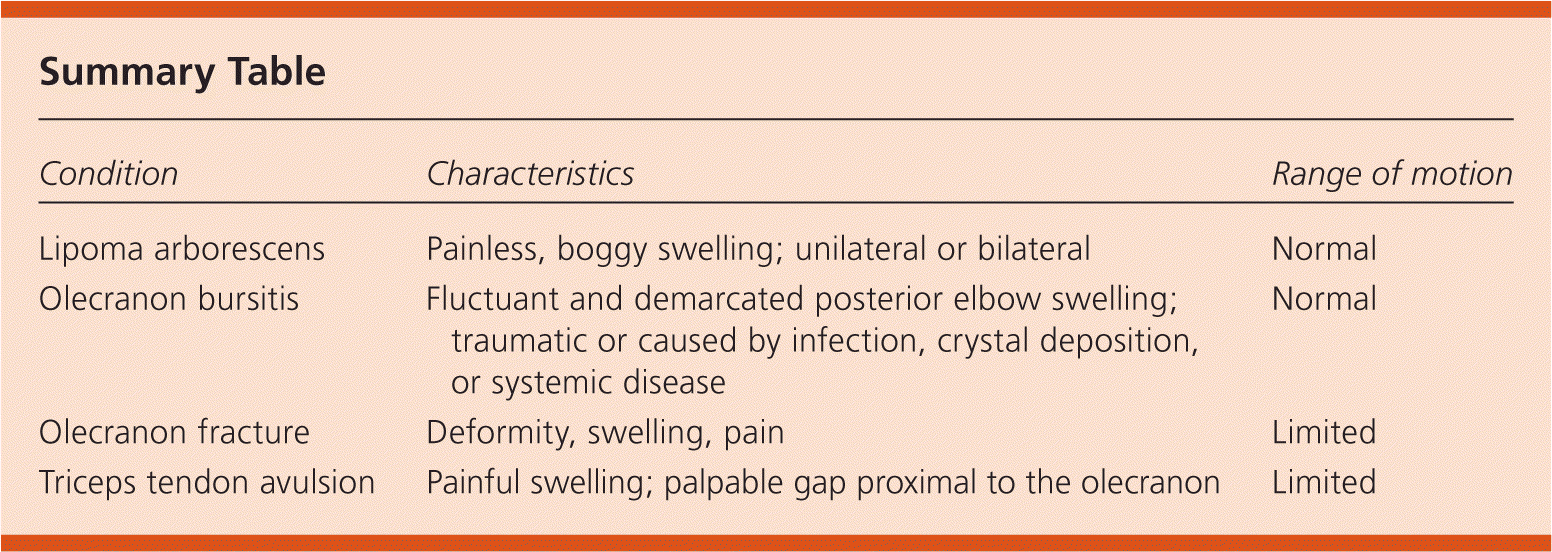
Am Fam Physician. 2016;94(3):243-244
Author disclosure: No relevant financial affiliations.
A 50-year-old man presented with swelling in his right elbow that began 10 days earlier. He had no history of injury to the arm, but he often rested his elbows on his desk at work. The elbow was not painful, and there was no arthralgia. He did not have a fever. His medical history was significant for chronic glomerulonephritis. He had been on hemodialysis for one year.
Physical examination revealed a spherical, fluctuant swelling over the posterior portion of the right elbow (Figure 1). There was no redness or tenderness to palpation, and range of motion was normal.

Question
Discussion
The answer is B: olecranon bursitis. This is a relatively common condition that most often affects men between 30 and 60 years of age.1 The classic finding is posterior elbow swelling that is fluctuant and clearly demarcated. It is often described as a “goose egg” over the olecranon process. The patient may report pain in the area of fluctuance, but the swelling is often painless, especially in noninflammatory, aseptic bursitis. The onset of olecranon bursitis may be sudden if it is secondary to infection or acute trauma. Range of motion in the elbow is usually normal, but there may be a slight limitation of the end range of flexion because of pain or bursal thickening.
Traumatic nonseptic bursal inflammation of the olecranon is common because of the superficial location of the bursa. There are several other possible causes of inflammation of the bursa, including infection, crystal deposition (gout or pseudogout), and systemic disease (rheumatoid arthritis, systemic lupus erythematosus, and uremia).2 The main risk factor for traumatic olecranon bursitis is repetitive pressure on the elbow.2 Persons who often rest their elbows on hard surfaces may develop bursitis; hence it is sometimes called “student's elbow.” A protective elbow padding, avoidance of pressure to the elbow, and limitation of activities are effective treatments.
Lipoma arborescens is a rare nonneoplastic intra-articular lesion that most commonly affects the knee and the suprapatellar bursa, and rarely affects the elbow joint. It presents as painless, boggy joint swelling with recurrent effusion. It is usually monoarticular but may occur bilaterally.
Olecranon fractures are a diverse group of injuries that often involve the elbow joint. Patients typically have a history of an injury. Patients with an olecranon fracture present with deformity, swelling, and pain. They have decreased range of motion and are often unable to fully extend the elbow.
Triceps tendon avulsion should be suspected in patients with a history of trauma who present with pain and swelling in the elbow. It usually follows indirect trauma but can occur after a direct blow to or fall on the elbow. The examination reveals swelling and a palpable gap proximal to the olecranon. With a complete rupture of the tendon, there is significant loss of extension range of motion and strength.

| Condition | Characteristics | Range of motion |
|---|---|---|
| Lipoma arborescens | Painless, boggy swelling; unilateral or bilateral | Normal |
| Olecranon bursitis | Fluctuant and demarcated posterior elbow swelling; traumatic or caused by infection, crystal deposition, or systemic disease | Normal |
| Olecranon fracture | Deformity, swelling, pain | Limited |
| Triceps tendon avulsion | Painful swelling; palpable gap proximal to the olecranon | Limited |
